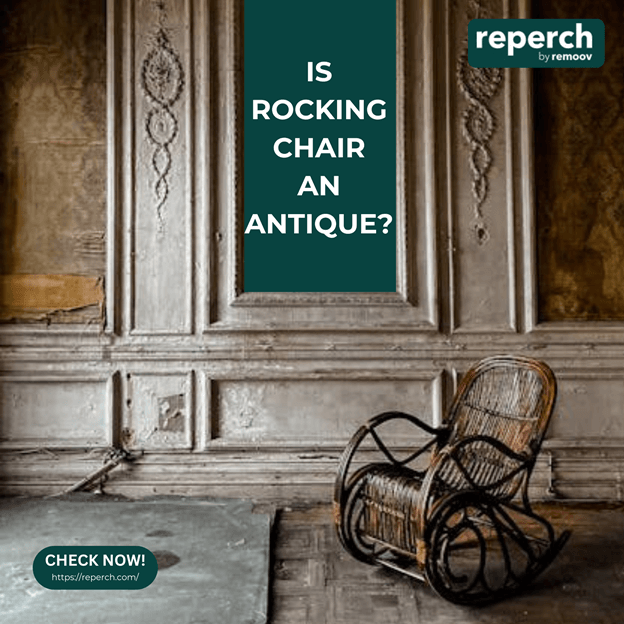Rocking chairs, with their soothing motion, have been a staple in homes for centuries. They're not only a place of comfort but also a piece of history, especially when they're antiques. Whether you're an avid collector or a curious buyer, knowing how to identify an antique rocking chair can add value to your purchase.
This guide will provide you with detailed insights into recognizing the age and authenticity of a rocking chair, ensuring you can distinguish a true antique from a modern replica.
Understanding Rocking Chairs: A Brief History
Although designs resembling rocking seats were visible in England and North America during the 17th century, rocking chairs originated in North America in the early 18th century. The rocking chair was first seen as a garden chair, but it moved indoors and gained popularity in American culture by the 19th century.
The Signs of an Antique Rocking Chair
Materials Used
Solid woods such as maple, cherry, walnut, and mahogany crafted early rocking chairs. The material can be a significant indicator of the chair's age. Hardwoods were common in older models because of their durability and availability at the time.
Design and Craftsmanship
The design elements of a rocking chair can tell much about its time period. Early American rocking chairs were simple with straightforward designs. Over time, the designs became more intricate, including carved details and curved lines characteristic of Victorian and later styles.
Tool Marks and Construction
Look for signs of handcrafting, such as uneven spacing of nails or slight asymmetry in the construction. Machine-made furniture, which began in the late 19th century, tends to be more uniform and precise. Hand-cut dovetail joints in the seat or back are also a good sign of an older, handcrafted chair.
How to Verify the Authenticity of an Antique Rocking Chair
Manufacturer's Marks
Many antique rocking chairs have a maker's mark, label, or stamp on the back or underside of the seat. These marks can provide valuable information about the chair’s origin and age.
Wear and Patina
Years of use will reveal signs of wear in authentic antique rocking chairs. Look for natural patina on the wood, especially on the arms and ends of the rockers, where hands and feet have made frequent contact.
Consult Historical Catalogs
Referencing old furniture catalogs or historical records can help confirm the style and period of your rocking chair. These resources may provide pictures or descriptions that match the design features of your chair.
Where to Find Antique Rocking Chairs
Antique Stores and Estate Sales
Genuine antiques, including rocking chairs, often stock these venues. Employees and sellers might also provide background information and verification of authenticity.
Online Marketplaces
Websites like eBay and Etsy offer a vast array of antique rocking chairs. However, one must exercise caution when verifying the authenticity of items purchased online. Whenever possible, it is advisable to request detailed photos and proof.
Caring for Your Antique Rocking Chair
Proper Cleaning Methods
Clean your antique rocking chair gently to avoid damage. Use a soft cloth and mild wood cleaner designed for antiques.
Avoiding Damage
Keep the rocking chair away from direct sunlight, which can fade and damage old wood. Also, maintain a consistent humidity level to prevent the wood from swelling or cracking.
Conclusion
Identifying an antique rocking chair involves a mix of historical knowledge, attention to detail, and sometimes a bit of detective work. Recognizing the signs of aging, understanding the materials and craftsmanship, and knowing where to look can greatly enhance your ability to spot a genuine antique.
FAQs About Antique Rocking Chairs
How do I know if my rocking chair is an antique?
Check for signs like hand-crafted details, use of hardwood, wear patterns, and any manufacturer’s marks.
What kinds of wood do antique rocking chairs typically use?
Maple, cherry, walnut, and mahogany are typical of older rocking chairs due to their durability.
Where is the best place to buy an antique rocking chair?
Antique stores, estate sales, and reputable online marketplaces are ideal for finding authentic pieces.
How should I clean my antique rocking chair?
Use a soft cloth and mild cleaner suitable for antique wood to prevent damage and preserve the chair’s original finish.
By understanding these elements, enthusiasts and collectors can add historically significant and beautiful rocking chairs to their homes, appreciating not just their aesthetic appeal but also their stories and heritage.








